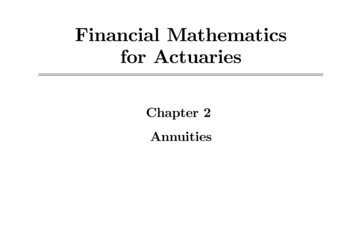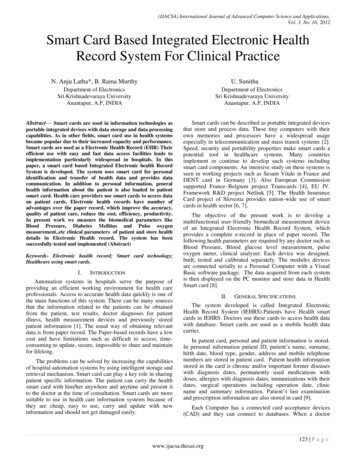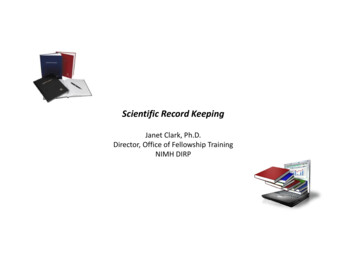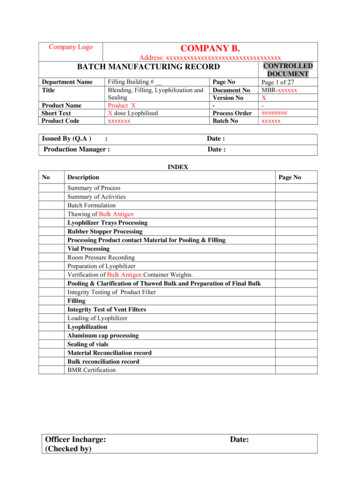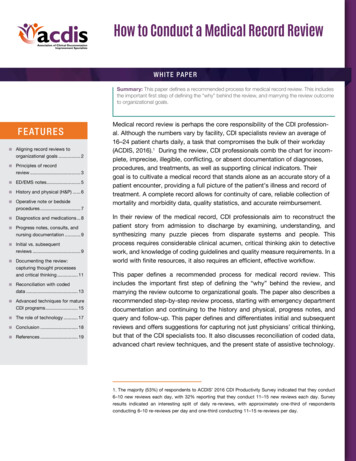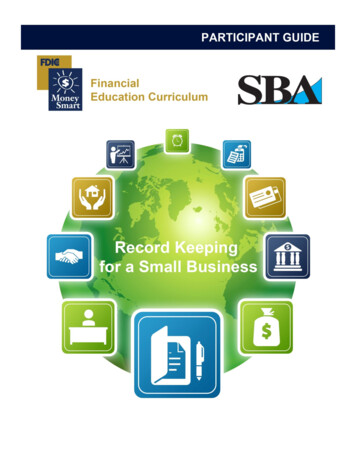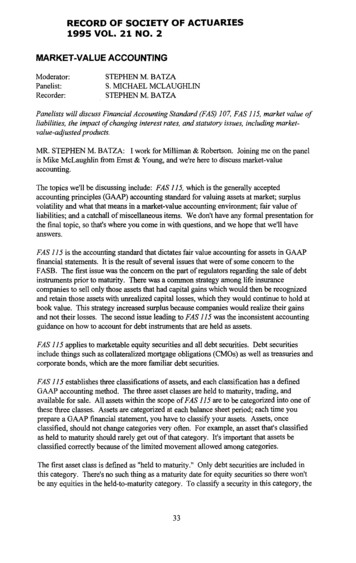
Transcription
RECORD OF SOCIETY1995 VOL. 21 NO. 2MARKET-VALUEModerator:Panelist:Recorder:OF ACTUARIESACCOUNTINGSTEPHEN M. BATZAS. MICHAEL MCLAUGHLINSTEPHEN M. BATZAPanelists will discuss Financial Accounting Standard (FAS) 107, FAS 115, market value ofliabilities, the impact of changing interest rates, and statutory issues, including marketvalue-adjusted products.MR. STEPHEN M. BATZA: I work for Milliman & Robertson. Joining me on the panelis Mike McLaughlin from Ernst & Young, and we're here to discuss market-valueaccounting.The topics we'll be discussing include: FAS 115, which is the generally acceptedaccounting principles (GAAP) accounting standard for valuing assets at market; surplusvolatility and what that means in a market-value accounting environment; fair value ofliabilities; and a catchall of miscellaneous items. We don't have any formal presentation forthe final topic, so that's where you come in with questions, and we hope that we'll haveanswers.FAS 115 is the accounting standard that dictates fair value accounting for assets in GAAPfinancial statements. It is the result of several issues that were of some concern to theFASB. The first issue was the concern on the part of regulators regarding the sale of debtinstruments prior to maturity. There was a common strategy among life insurancecompanies to sell only those assets that had capital gains which would then be recognizedand retain those assets with unrealized capital losses, which they would continue to hold atbook value. This strategy increased surplus because companies would realize their gainsand not their losses. The second issue leading to FAS 115 was the inconsistent accountingguidance on how to account for debt instruments that are held as assets.FAS 115 applies to marketable equity securities and all debt securities. Debt securitiesinclude things such as collateralized mortgage obligations (CMOs) as well as treasuries andcorporate bonds, which are the more familiar debt securities.FAS 115 establishes three classifications of assets, and each classification has a definedGAAP accounting method. The three asset classes are held to maturity, trading, andavailable for sale. All assets within the scope of FAS 115 are to be categorized into one ofthese three classes. Assets are categorized at each balance sheet period; each time youprepare a GAAP financial statement, you have to classify your assets. Assets, onceclassified, should not change categories very often. For example, an asset that's classifiedas held to maturity should rarely get out of that category. It's important that assets beclassified correctly because of the limited movement allowed among categories.The first asset class is defined as "held to maturity." Only debt securities are included inthis category. There's no such thing as a maturity date for equity securities so there won'tbe any equities in the held-to-maturity category. To classify a security in this category, the33
RECORD,VOLUME21company must have both a positive intent and the ability to hold it to maturity. If it'sobvious that you can't hold a specific asset to maturity, you can't put it in theheld-to-maturity class. Assets classified as held to maturity are held at amortized cost, sothey have no market-value adjustment.The second asset class is identified as the trading class. These are debt and equity instruments that are acquired for very short periods of time, and you fully expect to Wade them.These assets are not being used to back any long-term liabilities; they are usually assets thatyou buy and sell with the intent of making a quick profit. As a matter of fact, buying andselling in this category is mandatory. You can't put an asset in this class and keep it therefor an extended period of time. I don't know if there is an established standard regardingthe length of time you can hold an asset in this category. I think if you held it for more thana year, there would likely be some concern that you're not really trading that asset. Assetsin this class are carried in GAAP financial statements at market value; debt instruments aretherefore directly affected by changes in interest rates. As interest rates rise, the marketvalue of debt instruments decreases, and as interest rates decrease, their market valueincreases. Even if you haven't sold these assets yet, if they're sitting in your tradingcategory, any unrealized gains go through your earnings statement. These assets are treatedessentially as if they're sold and repurchased on the date they are valued.The third class is sort of a catchall class fbr assets, and this is the available-for-salecategory. This category includes debt and equities, and they are carried at fair value. Thedifference between this class and the trading class is that these unrealized gains and lossesgo through equity. They do not come through the income statement. Changes in marketvalue for this category would therefore show up as changes to policyholders' orshareholders' equity.Now that we've defined the three classes of assets, the question is, what did companies dowhen this became effective? FAS 115 became effective right at the end of 1993 or at thebeginning of 1994, however you want to look at it. At that point in time, companies had toassess how to allocate their assets. In the middle of 1994, several surveys were conducted,and the results showed that between 70% and 80% of life insurance company assets wereallocated to the available-for-sale category. I say between 70% and 80% because itdepends on which survey you look at. The results of one survey had it at about 70%, andthe results of another survey had it at about 80%. Regardless of which one you look at, it'sobvious that the bulk of the assets have been allocated to the available-for-sale category.What were the reasons for this allocation? I think we'd like to look at the results and saythat management made a conscious decision that, based on its conclusion that portfolioflexibility was imperative, it had to be able to buy and sell assets. In other words, thedecision was that portfolio flexibility is more important than equity stability. The moreassets that are put in the available-for-sale category, the more you're at risk that changes ininterest rates will increase or decrease GAAP surplus due to changes in market value. Inreality, many decisions to allocate assets to the available-for-sale category were likely dueto the interest rate environment at the time. When FAS 115 became effective, interest rateswere low; there were large unrealized gains in insurers' portfolios on a market-value basis.So the interest rate environment helped push the decision to put assets in the34
MARKET-VALUEACCOUNTINGavailable-for-sale category. The combination of portfolio flexibility and low interest ratesat the time FAS 115 was adopted led to the large distribution of assets in the available-forsale category.Well, that allocation was made at the end of 1993 or at the beginning of 1994, but whathappened as we went forward in 1994? Interest rates began to rise, and the market value ofcompanies' debt instruments began to fall. Companies suddenly experienced a fairly largedeterioration in their GAAP capital because they had a large proportion of their assets in theavailable-for-sale category, and they were really unable to do anything about it. As themarket value of these assets fell, companies' GAAP capital fell also. You did get someoffset from what is known as a shadow deferred acquisition cost (DAC), but that offsetwasn't that great.The shadow DAC is a concept that was introduced by the SEC. When DAC is amortizedunder FAS 97 or under the new GAAP for mutuals standard, it is being amortized overestimated gross profits or estimated gross margins. Included in those gross profits andgross margins are gains on interest, but they exclude unrealized gains and losses. The SECcame in and said now that there is market-value accounting, unrealized gains and lossesmust be included in insurance company statements. So the SEC mandated a notional DACamortization that includes unrealized gains and losses. This has become known as the"shadow DAC;" it includes unrealized gains and unrealized losses as part of estimatedgross profits and estimated gross margins. The shadow DAC does not affect theamortization of DAC in the income statement, but it does affect equity. For example, ifthere is a rising interest rate environment, the value of your portfolio drops, and you haveunrealized losses. Those unrealized losses reduce the estimated gross profits and youamortize less of the shadow DAC. So there is some offset from the FAS 115 market-valueadjustment by virtue of the shadow DAC, but it certainly does not completely offset thoseadjustments.The differences between the actual DAC and the shadow DAC are reflected in equity; theydo not go through the income statement. There are limitations to what shadow DAC can dofor you. First of all, the maximum DAC cannot exceed the original DAC plus accruedinterest. For example, if you have not amortized much shadow DAC to start with and youhave significant unrealized losses, the best you can do is write the DAC back up to itsoriginal amount plus accrued interest. The second limitation is obvious: your shadowDAC can't go below zero. If you've written offall your shadow DAC, there would be noequity adjustment for unrealized gains. The third limitation is one that you've always hadwith GAAP accounting--recoverabilityand loss recognition issues. You can't hold DAC ifyou can't recover it. Your net GAAP liability must be appropriate for the productsinvolved.So how are companies coping with FAS 115? It has been a big change, and it has led tosome confusion among investment bankers and others in the industry. Some companieshave been reporting numbers with and without the effects of FAS 115. This has led tocomparability issues, especially for those companies with a majority of their assetsallocated to the available-for-sale category. Companies are now realizing that they have toreduce the volatility of their portfolio. One of the things that they're doing is classifyingmore new assets as held to maturity. You have to be cautious when you employ this35
RECORD,VOLUME 21strategy because assets in this class are difficult to reclassify. FAS I15 defmes severalspecific situations when you can sell a held-to-maturity asset. Among those are: The borrower experiences a deterioration of creditworthiness. There's a change in the tax law that affects the taxability of the security. The entity that issued the debt security undergoes a major business combination ordisposition. There are changes in statutory or regulatory requirements. There are changes in any risk-based capital (RBC) requirements or any change inthe RBC formula that would negatively impact a company.In most cases, once you classify an asset as held to maturity, you really have to hold it untilmaturity. A second strategy companies are employing is shortening their portfolioduration. For example, if you have a 30-year bond and hold it to maturity, that bond isgoing to have large swings in value when interest rates change. To avoid this, companieshave reduced their portfolio duration by purchasing three- or five-year securities. Thatreduces the market-value volatility, but now you have to be careful that you haven't createdan asset/liability mismatch. "l-hismay result in additional reserves when you do your cashflow testing. A third strategy, which I don't believe is widely used yet, is using derivativesto hedge some of the volatility. I know some companies are looking at it, but I don't knowof any specific examples in wtfich they have been successful. If anybody has employed ahedging strategy to deal with FAS 115, I'd like to hear from you later.What FAS 115 has taught everyone is that now we really have to complete the job. FAS115 addresses only one side of the balance sheet, the asset side, and it has created all kindsof movements in GAAP surplus. These one-sided movements are difficult to manage.There is now a much greater interest in completing the job, and that is developing a marketvalue accounting of liabilities. Right now liabilities aren't marked to market. I thinkeverybody's liabilities are statutory reserves or GAAP reserves so they don't adjust tochanges in the market like assets are now required to do. With that said, Mike McLaughlinwill talk about the different scenarios on the table for market-value accounting of liabilities.MR. S. MICHAEL MCLAUGHL1N: I work in the Chicago office of Ernst & Young, andone of my significant areas of work is GAAP financial reporting, both for stock companiesand mutuals. I will talk about primarily two things. First, rll go through a specificexample with regard to surplus volatility to pick up on some of the points that Steve made.Second, I'll cover the method of determining fair value of liabilities.As you know, FAS 115 has created a significant concern about surplus volatility because ofthe holding of certain assets at fair value or market value while liabilities are held at bookvalue. This was of concern to the industry from the very beginning of FAS 115 as anexposure draft. At the public hearings that the FASB held in 1993, several comments weremade by representatives of the banking industry, the insurance industry and, of course, theactuarial profession, that this surplus volatility would exist. There were several reasons forFASB proceeding nonetheless. It is a fact that surplus volatility is and continues to be aconcern to insurance companies, perhaps less so to banks than was originally thought. I'dlike to go through a simple example that will help explain what's going on here.36
MARKET-VALUEACCOUNTINGLet's look at a typical company that sells universal life (UL) or single-premium deferredannuity (SPDA) business (Table 1). We'll make our example a SPDA-type company thathas 100 of total assets. Invested assets total 90 of which 60 are classified as availablefor sale. This example is intended to be generally representative of the industry. The vastmajority of assets of stock and mutual companies in the industry have been classified asavailable for sale because of the need to retain investment flexibility despite surplusvolatility. We're going to assume for our example that these assets have an effectiveduration of five, thus a i% increase in interest rates would reduce the value of these assetsby 5%. We have 30 of assets classified as held to maturity, and we have the positiveintent and ability to hold those assets to maturity. Nothing short of a major change in thenature of the asset itself would permit us to move assets out of that category. The assetswould be transferred at market value, which typically would occur only due to a majorchange in the credit quality of the asset or perhaps some regulatory or statutory change inthe treatment of the asset for presentation purposes.TABLE 1SURPLUSVOLATILITYExample--Current Interest RatesAssetsInvestments-available for saleInvestments-held to maturityDeferred acquisition costTotalAssets 603010 100LiabilitiesReservesDeferredtaxesEquityTotal liabilities and equity 902J 100In this example, we have 10 of DAC and a total of 100 of assets. On the liability side,we have reserves equal to the account balance of 90. In our example, we'll say that theeffective duration of the liabilities is three. There's a deferred tax liability posted inaccordance with FAS 109 of 2, which represents the tax effect of the difference betweenGAAP net liabilities and tax reserves. That is the extent to which future taxes will need tobe paid by this example company. We have equity of 8. Thus, our base case scenario isgenerally representative of the structure on a very simplified basis of an annuity-writingcompany.In Table 2, we look at the situation after interest rates have risen 2%. Taking a look at eachline in our balance sheet in turn, available-for-sale investments have reduced in value by10%; thus, 60 has become 54. Our held-to-maturity assets remain at 30. The DAC was I0 but has increased to 12. This is part of the effect that Steve had talked about earlier.We need to reexamine the DAC on account of treating those unrealized losses of 6 ( 60less 54) as if realized. In reporting our balance sheet, we take a look at the unrealizedlosses of the current year. All assets are deemed in this simple example to be held insupport of the liabilities, and thus this 6 loss will be reflected in our amortization scheduleas part of our estimated gross profits. We would typically also take a look at what futurespreads would be after experiencing a 2% interest rate rise. It's very likely in that situation37
RECORD, VOLUME 21that future spreads would have increased, and so the rise of 2% in interest rates has caused acurrent unrealized loss, but it's probable that future increased spread will, to a large extent,tend to offset that unrealized loss. Thus, the combined effect of the current year and thefuture year's changes due to the unrealized loss is that the total present value of estimatedgross profits is not very different. Thus, the fraction of total estimated gross profits neededto amortize the DAC doesn't change very much.TABLE 2SURPLUS VOLATILITYExample-InterestRates Rise 2%AssetsInvestments-available for saleInvestments-held to maturityDeferred acquisition costTotalassetsLiabilitiesReservesDeferred taxesEquityTotal liabilities& equity 54301 .22 96 90.00.7.5, 96.0'JJrJ''In this exanaple, the amortization rate is about a third so about 33% of estimated grossprofits are required to amortize DAC. With the current year unrealized loss, our DAC hasgone up by about one-third of the 6 uatrealized loss, and so the DAC has gone from 10 to 12 in this example. Our overall assets have gone to 96 so there's been a net reduction.But as you can see just at this level, there's somewhat of a dampening effect because of theincrease of DAC, which moves in the opposite direction of the unrealized loss. Let's take alook at the liabilities.Although these reserves have a duration of three, their carrying value has not changed at all.Of course, we are not permitted to report those liabilities at their fair value. Instead weshow their book value, which is exactly the same as before, On the next line, the deferredtax liability has been reduced. We're reflecting the change in the differences of GAAPreserves relative to tax. We have a current year 6 unrealized loss; however, we have anoffsetting increase of 2 of DAC so we have a net 4 reduction in the timing difference.There is a favorable effect here to the extent of the assumed tax rate of 34% multiplied bythat net difference. This results in a favorable adjustment of 1.3 to the deferred tax liability.This serves to further dampen the effect of the unrealized loss. Hence, equity is not hit bythe full 6 of unrealized loss, but is reduced significantly by both the increase in DAC andthe decline in the deferred tax liability. The equity that we reported prior to this increase ininterest rates has gone from 8 to 5.30. This is an example of the volatility that remainsbecause of the FAS 115 treatment of assets and liabilities.Depending on the particular products in question, the amortization rate could be larger thanthe example shown here. For some UL-type products, for example, the amortization rate ismuch higher, perhaps 80% or 90%. In that case, there would be a larger dampening effectcaused by the DAC.38
MARKET-VALUEACCOUNTINGHowever, there are some limits again as to how high and how quickly the DAC can movebecause of the constraints of loss recognition. Also, based on the SEC's 1994announcement letter, the DAC can't be increased boundlessly; instead, it would only beincreased to its initial amount plus accrued interest at the DAC amortization rate.With regard to deferred taxes, interestingly, one or two of our clients are fraternal. They donot pay federal income tax, a
FAS 115 establishes three classifications of assets, and each classification has a defined GAAP accounting method. The three asset classes are held to maturity, trading, and available for sale. All assets within the scope of FAS 115 are to be categorized into one of these three classes. Asse

